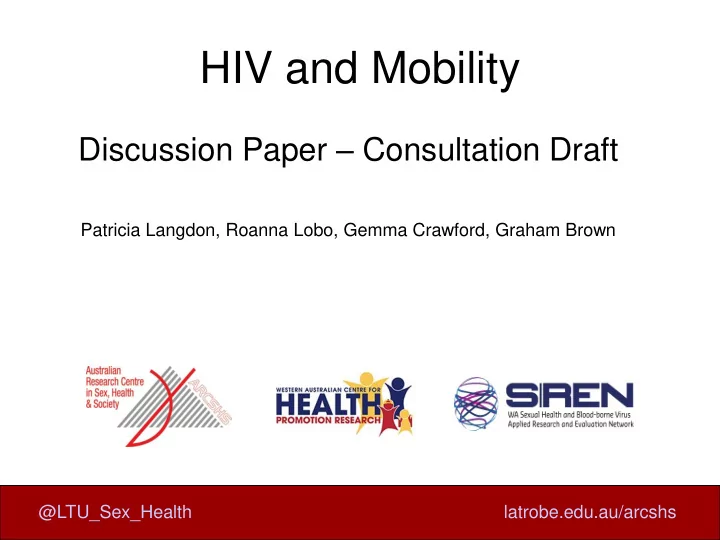

HIV and Mobility Discussion Paper – Consultation Draft Patricia Langdon, Roanna Lobo, Gemma Crawford, Graham Brown Melbourne, Australia @LTU_Sex_Health www.latrobe.edu.au/arcshs latrobe.edu.au/arcshs
HIV and Mobility Project • The aims of the project were to undertake a scoping and mapping exercise to: – Identify and review current programs and activities which have been implemented to respond to overseas-acquired HIV (in Australia and similar epidemics globally); and – Develop recommendations for future targeted research and interventions for priority populations to generate further discussion and support advocacy endeavours. . Melbourne, Australia www.latrobe.edu.au/arcshs
HIV and Mobility • Part 1: HIV and mobility in Australia: setting the scene • Part 2: Roadmap for action: responding to HIV and mobility issues in Australia Melbourne, Australia www.latrobe.edu.au/arcshs
Part 1: Setting the Scene 1.0 H ISTORICAL CONTEXT 2.0 L INKS BETWEEN HIV AND MIGRATION 3.0 HIV AND MOBILITY IN A USTRALIA 4.0 HIV EPIDEMIOLOGY 5.0 G LOBALISATION 6.0 M OBILITY 6.1 M ASS MOBILITY AS A RESULT OF GLOBALISATION 6.2 T HE DRIVING FACTORS OF MASS MOBILITY 6.3 M ASS MOBILITY AND THE IMPACT ON HIV RISK AND VULNERABILITY 6.4 T YPES OF MOBILITY 6.5 M IGRANT ARRIVALS IN A USTRALIA 6.6 P ERCEPTIONS OF MIGRANTS IN THE UK AND A USTRALIA 7.0 G LOBAL HEALTH GOVERNANCE STRUCTURES 8.0 P OLICIES , FRAMEWORKS , STRATEGIES AND PROGRAMS IN A USTRALIA AND INTERNATIONALLY 8.1 E XAMPLES OF THEORETICAL FRAMEWORKS THAT INFORM RESPONSES IN A VARIETY OF SETTINGS Melbourne, Australia www.latrobe.edu.au/arcshs
KEY CONCEPTS – Globalisation and the confluence of social change • Mobility has been described as exacerbating risk factors, a structural context, a determinant, a social driver, and as a risk factor in and of itself. • There are different types, motivations and directions for mobility - some of which confer greater or less risk to the person. Melbourne, Australia www.latrobe.edu.au/arcshs
KEY CONCEPTS – Global health governance • Traditional ‘contain and control’ public health interventions are ineffective in dealing with HIV. • Global economic structures have paid little attention to health impacts of globalisation, inequitable health systems and other public health threats. • It can be hard to engage a ‘moving’ target without effective structural enabling environments and with countries operating in isolation Melbourne, Australia www.latrobe.edu.au/arcshs
Part 2 – Road Map for Action: responding to HIV and mobility issues in Australia A ustralia’s response to HIV 9.0 10.0 Priority populations in the context of mobility 11.0 Application of priority areas in the 7th national strategy for HIV/AIDS to HIV and mobility 12.0 Principles for developing a strategic approach to HIV management for mobile populations and migrants in Australia 13.0 Six areas for action Melbourne, Australia www.latrobe.edu.au/arcshs
Testing as an example For ethical voluntary HIV testing with our newly arrived migrants from high prevalence countries, the following issues must be resolved : • A whole of government approach to the health and wellbeing of migrants; • Social capital must be built and supported in migrant communities • Societal stigma and discrimination , the rights of migrants to receive equitable access to health services, and the threat of deportation regarding HIV and visa status needs to be addressed; • Access to testing (and treatment) facilities must be culturally sensitive and accessible; and • Structural barriers to testing such as cost, location, access to interpreter services must be addressed. Melbourne, Australia www.latrobe.edu.au/arcshs
Ten principles for developing a strategic approach to HIV management for mobile populations and migrants in Australia: 1. Pay attention to the confluence between HIV and mobility 2. Participate in and contribute to global health governance 3. Commit resources to improve migrant health 4. Acknowledge that mobile population and migrants need more than information (even if it is translated). Specialist services as well as generalised services need to be provided 5. Incorporate a human rights approach - stigma and discrimination directed at mobile populations and migrants must be reduced Melbourne, Australia www.latrobe.edu.au/arcshs
Ten principles for developing a strategic approach to HIV management for mobile populations and migrants in Australia: 6. Reduce all barriers to testing and access to treatment 7. Move beyond ‘narrow protectionist policies’ 8. Continue surveillance and monitoring and develop evaluation strategies in conjunction with migrant populations 9. Continue to develop links and cooperative partnerships with migrant and ethnic groups at a local and international level 10. Closer cooperation between Australia and the HIV policy, public health, treatment and support sectors in countries of origin and destination for Australian mobile populations and migrants Melbourne, Australia www.latrobe.edu.au/arcshs
Six areas for action Six areas for action are proposed. These are: • International leadership and global health governance (9 proposed strategies) • Commonwealth and state leadership (13 proposed strategies) • Community mobilisation (13 proposed strategies) • Development of services for mobile or migrant people and groups (19 proposed strategies) • Surveillance and monitoring (10 proposed strategies) • Research and evaluation (10 proposed strategies) Melbourne, Australia www.latrobe.edu.au/arcshs
What is not in the draft report? • Impact of HIV and Mobility on regional and Aboriginal communities • Role of faith based responses with migrant communities (for whom secular community responses may be less familiar) • Role of the diaspora to influence future migrant networks Melbourne, Australia www.latrobe.edu.au/arcshs
Five immediate actions for WA • Get HIV and mobility on the interstate and national agenda, and highlight the national legislative and policy barriers to effective programs in WA • Build formal partnerships across the HIV, migrant, and key resource, health insurance and travel industry sectors and program investments • Find ways to remove structural and social barriers to testing and treatment for mobile and migrant populations • Support capacity of peer advocacy networks within migrant and mobile populations • Prioritise applied strategic research to directly support and guide the investment Melbourne, Australia www.latrobe.edu.au/arcshs
Next steps Access hard or electronic copy of report and feedback sheet. siren.org.au/current-research/ Feedback to siren@curtin.edu.au by 5pm Thursday 21 August, 2014 . Melbourne, Australia www.latrobe.edu.au/arcshs
HIV and Mobility Discussion Paper – Consultation Draft Patricia Langdon, Roanna Lobo, Gemma Crawford, Graham Brown Melbourne, Australia @LTU_Sex_Health www.latrobe.edu.au/arcshs latrobe.edu.au/arcshs
Recommend
More recommend